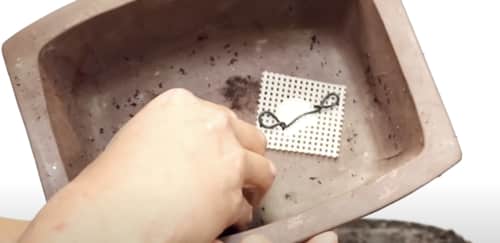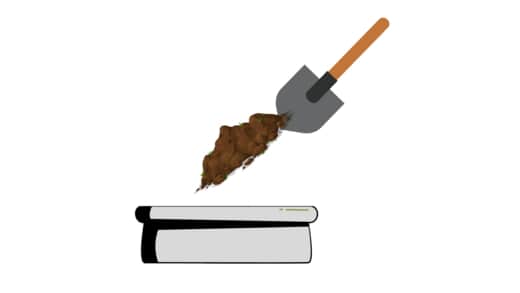This website is supported by its readers. If you click one of my links I may earn a commission. I am also a participant in the Amazon affiliates program and I will also earn a commission from qualified purchases.
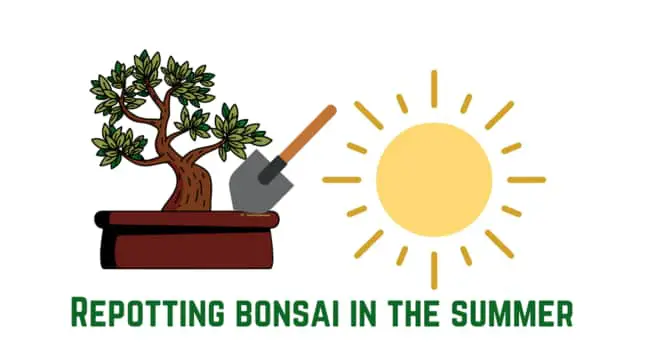
Repotting a bonsai is one of the most common bits of maintenance we bonsai owners will have to do. Repotting is usually done during the spring. That being said, my full-time job kept me super busy this spring so that got me thinking, is repotting bonsai in summer a viable option?
Repotting a bonsai in the summer months is uncommon but can be done successfully. This is because bonsai is still in the growing season from spring to summer, which will last until the middle of September. The effects however will not be as strong as repotting in the early spring.
So what are the major difficulties of repotting a bonsai in the summer months? And how exactly do you repot a bonsai tree? Keep reading to find out more.
Just a quick heads up, over the past three years of running Plantpaladin, hundreds of people have asked for product recommendations. As such, You can find my favorite indoor bonsai tree here (link takes you to Bonsaiboy), my favorite outdoor bonsai tree (link takes you to Bonsaiboy), or have a look at all the products I recommend here.
Repotting bonsai in the summer
Repotting a bonsai is one of the most common aspects of being a bonsai owner.
It is done as a way to ensure that we bonsai owners maintain the health of the roots of our bonsai without them getting too cramped in one space.
If your bonsai is left in the same pot for years at a time, it will impact your bonsai ability to absorb water, nutrients and get sufficient air, potentially killing your plant.
Whilst some people opt for root pruning as a way to maintain the health of their bonsai, the truth of the matter is that if you leave your bonsai unchecked for years, it will get harder to maintain without repotting your bonsai.
Repotting a bonsai then is typically done during the spring when your bonsai energy cycle is at the point where it will transfer energy from the roots to the tree.
In layman terms, it will mean that your bonsai will grow a lot more during the spring months.
Can you repot a bonsai in the summer?
Luckily I’ve scoured the web, visited a few garden centers, have experience repotting a bonsai in the summer myself, and even asked a few of our readers from Plant Paladin on their thoughts on repotting bonsai in the summer.
Here are the findings:
- Repotting a bonsai in summer, if done carefully is an acceptable alternative to repotting bonsai in the spring
- This is because bonsai in the summer are still in the growing phase during the summer months and can still gain some of the potential health benefits of repotting bonsai in the summer
- Repotting a bonsai will work for most bonsai species, but works particularly well for tropical species such as olive or weeping fig.
- Ideally, you would want to repot the bonsai as early in the summer as possible in June and avoid repotting the bonsai in September.
- Repotting in the summer however should be avoided if there is a heatwave approaching. Most bonsai cannot survive in extreme temperature ranges so if a heatwave approaches it is more beneficial to leave your bonsai as they are.
- Repotting a bonsai in the autumn or winter is not advisable, however. This is because bonsai will be more susceptible to colder or freezing temperatures and your bonsai will already be gearing up the process of the energy cycle to conserve as much energy as possible for the winter months.
Which of the summer months is best to repot a bonsai in?
Early June or as early in the summer months as possible is the best time for repotting a bonsai in the summer. This is because your bonsai has more energy in the leaves than the roots, and you will be mimicking as closely as possible the spring months.
Now this is quite a lot of information to take in so to help explain in more detail I’ve created a table below which goes into more detail about the different months
|
Month |
Explanation |
| June | The best month outside of the spring months to repot a bonsai as it is closest to the spring months. Bonsai should still have a lot of energy in the leaves for photosynthesis. Ensure you avoid repotting this month should it be exceptionally warm |
| July | Bonsai repotted in July can still be successful, you just need to ensure that you take extra care of water intake and root mass. If your check the root and they are not circling your pot then you won’t need to repot your bonsai |
| August | By August you should only repot that your bonsai is necessary and the roots are starting to affect your tree. To check for this, remove your bonsai from the pot, should the roots be encircling the pot, interfering with the rest of the roots then you can repot. |
| September | By September the energy transfer of your bonsai will start to diminish, going back into the roots of your tree. Bonsai repotted late into the month may not yield any benefits. |
Why do people like repotting bonsai in summer?
Bonsai owners who repot their bonsai in the summer months do so typically because they have not had the time to repot their trees in the spring. This is also common if they own a tropical species which works or their climate is susceptible to a mild summer.
People typically repot their bonsai in the summer because of one of the following reasons:
- Lack of time to repot bonsai in the spring
- Living in a cooler climate during the summer months
- Owning a tropical species of bonsai that is more susceptible to warmer weather
- The stress incurred repotting your bonsai in the summer will be less than repotting in the autumn or winter months.
- The tree is young and healthy
What bonsai trees should not be repotted in the summer?
Older bonsai trees should not be repotted in the summer instead opting for the spring to repot them. Trees that are unhealthy, require a lot of root pruning, will be replanted in poor soil conditions, or an extremely hot environment should also avoid being repotted in the summer.
Let’s explore these in more detail below:
Older trees
Despite some bonsai living for hundreds or in some occasions thousands of years, the older bonsai get, the more care is required for their upkeep.
Repotting a bonsai is a stressful environment even for the healthiest of trees and so repotting a bonsai for an older tree should be avoided in the summer months and only be done in early spring.
Unhealthy trees
Similar to older trees, should your bonsai have an infection such as white spots on its leaves, a fungal infection, an insect infestation, if your bonsai is dropping leaves or has yellow leaves then you should avoid repotting your bonsai.
This is because your bonsai is fighting off an issue relating to watering, nutrition, or poor upkeep and you need to resolve those problems before deciding to repot.
Trees that require a lot of pruning
As mentioned, stress is one of the hardest parts brought about in the repotting process.
When repotting bonsai you will be pruning a lot of the roots of your tree.
Should you have a lot of dead roots or roots that need pruning leaving only a handful then it is not ideal that you repot your tree during the summer months.
Instead, repot them either in the spring or wait until next summer so these roots have a chance to heal.
Poor soil conditions
A lot of us bonsai enthusiasts know when we have good soil conditions for our bonsai that not only allows water to flow through easily but also retains the right moisture.
If then you are repotting a bonsai you will need to invest in new soil and if you know that you are moving your bonsai into a pot with less than optimal soil, it should be avoided in the summer months, which can be particularly brutal for the trees.
Instead either repot in the spring or opt for a strong soil mix – I like to use cactus soil.
Warm weather
If your temperature gets higher than 90 degrees Fahrenheit (32 degrees C) for a significant period of time in the summer then it is best to avoid repotting your bonsai.
Your bonsai will need to take a few weeks to adapt to its new pot and condition and will be more susceptible to dehydrating from warm conditions.
Warm conditions which if exceed 90 degrees F for a long period can prove to be deadly.
Benefits of repotting bonsai in the summer
The main benefits of repotting a bonsai in the summer are that it helps bonsai owners manage their time when maintaining bonsai collections. Repotting bonsai in the summer is also better than repotting in the fall or winter with more sunlight to help the repairing process of repotting.
Let’s explore these in more detail:
Good for large bonsai nurseries
Whilst a lot of us amateurs (myself included) get involved in the art of bonsai with one or two trees, sooner or later we have full-blown collections to our name.
Checking what plants need to be repotted and then repotting them all during the spring can be stressful, especially if you work a full-time job.
Repotting bonsai in the spring and summer months will help spread the load for bonsai owners making the process easier to manage.
Better than repotting bonsai in the fall or winter
Whilst the spring months are still the best months when it comes to repotting a bonsai, repotting a bonsai in the fall or winter should be avoided.
This is because of the energy cycle associated with bonsai.
During the spring months, energy flows from the roots of your bonsai into the tree in deciduous trees.
This allows them to start to bloom and grow new leaves.
In the fall or winter, the energy flows from the tree back into the roots as a form of storage during the harsh months.
Planting and repotting your bonsai in the summer months, when this energy flow is still in the leaves, is much better than repotting your bonsai in the winter months – giving you bonsai a chance to recover from the process.
Especially if your bonsai was planted near the beginning of summer.
The most amount of food for plants
Photosynthesis, as I’m sure you are all aware, is the process plants use to get their food. – they use sunlight for energy and food.
In the summer months, average temperatures and sunlight are typically at their highest in most countries.
This means that your bonsai will have the most food which it can use as energy to help heal the process of plant repotting in summer which can be incredibly stressful.
Drawbacks of repotting bonsai in the summer
The main disadvantage of repotting a bonsai tree in the summer is the stress associated with the repotting process and the amount of time your bonsai will have to recover. Other drawbacks include interfering with the energy cycle of a tree and an increased chance of heat-inflicted stress.
Again let’s explore these in more detail below:
Stress
Easily the biggest drawback when it comes to repotting your bonsai in summer is the stress associated with the repotting process.
Repotting a bonsai is incredibly stressful on not just the roots of your tree, but all areas of the plant.
As such if you are going to repot your bonsai at a time that is not optimal, it will take longer to recover and adapt to its new pot.
This can lead to an increased chance of getting a disease.
Longer time to heal
Similar to the points above, if your bonsai is recovering from a stressful activity such as repotting, it will take time to heal.
Now if you are repotting your bonsai in the summer this will take significantly longer due to a lot of the energy in your tree already being used to painting the health of your bonsai.
Think of it as running a marathon – you wouldn’t run a marathon whilst you were already exhausted as that would be less than optimal – the same goes for repotting in the summer months.
Interferes with the energy cycle of the bonsai
As mentioned earlier, the optimal time to repot a bonsai is as soon as the buds for your leaves start to bulge.
This is a surefire sign that the energy from your tree has transferred from the roots of your plant to the rest of the tree.
During the summer months, your bonsai will already be in full bloom meaning that it will be more difficult to navigate this energy flow with there only being a few weeks until the energy starts to flow back into the roots of your tree – preparing your bonsai for winter.
Increased chances of heatstroke
With climate change and global warming increasing rapidly year on year, summers are becoming warmer.
Repotting bonsai in the summer then means you will have a higher chance of underwatering your bonsai or other heat-prone effects caused by repotting a bonsai in the summer such as dry shriveled branches or discolored leaves.
How to repot a bonsai in the summer
So now we know that repotting a bonsai in summer is a viable option. Let’s explore the steps needed to repot a bonsai in summer.
Before you get started you will need:
- A new bonsai pot (link takes you to Amazon)
- Drainage Mesh (link takes you to Amazon)
- Root Cutters (link takes you to Amazon)
- Wirecutter (link takes you to Amazon)
- 2mm Wire (link takes you to Amazon)
- Root Hook (link takes you to Amazon)
- Repotting Stick (link takes you to Amazon)
- Pliers (link takes you to Amazon)
Check that your plant can be repotted
So before we repot a bonsai the first thing we need to do is check that it is ripe for repotting.
As mentioned through this post, repotting works best on bonsai when the energy cycle of a tree has just started.
This typically happens in early spring but can be done through the spring and summer months.
The best sign to look out for are enlarged or expanding buds on the breaches of your bonsai.
If you repot your bonsai at this point, it will have the longest period possible to adapt to its new environment.
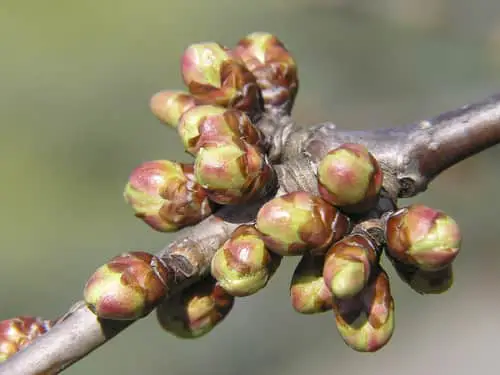
Check the weather forecast
For those of you unable to repot your bonsai in the early spring and instead repot in the summer it’s important that you check the weather forecast.
Repotting a bonsai is a stressful process for your tree and if you do it during a heatwave you are adding unwanted stress to your tree.
The best temperature to keep your bonsai at is between 10 to 85 degrees Fahrenheit (-12 degrees to 29 degrees Celsius).
So if a heatwave is coming, especially in the few weeks after you repot your bonsai, you will want to avoid this.
Select the right pot
The next most step is to find a new pot that your bonsai will need to be kept in.
This consists of two main factors:
- Drainage holes
- Overall size
Drainage holes
You want to make sure that your bonsai tree has enough drainage holes to allow enough water to flow through but also not too many so that your bonsai will hold on too to much moisture.
This will vary from bonsai to bonsai but as a good rule of thumb aim for two penny-sized drainage holes ( this will be the example we will use throughout this post)
If you have a miniature bonsai or an emperor sized bonsai have a look at the table below or check out my post on bonsai size classification:
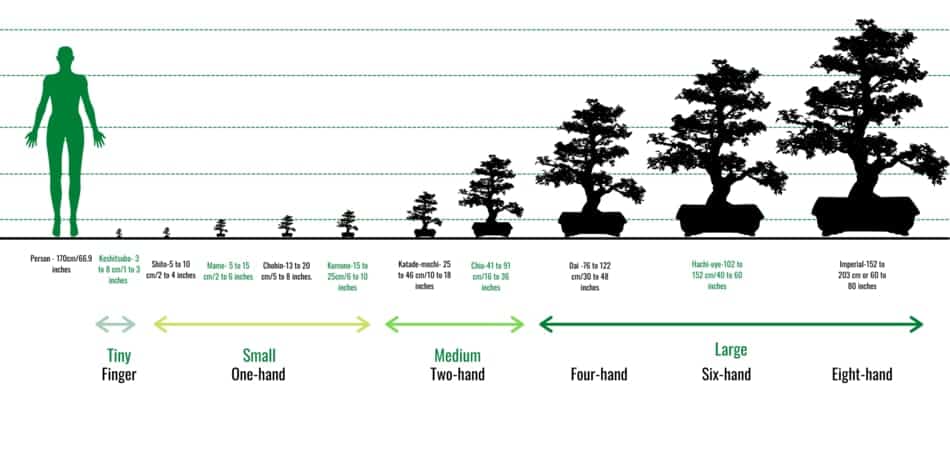
| Classification | Size inches | Number of penny-sized holes | Number of pencil-sized holes |
| Keshitsubo | 1 to 3 inches | 1-2 | 0 |
| Shito | 2 to 4 inches | 1-2 | 0 |
| Mame | 2 to 6 inches | 2 | 2 |
| Chohin | 5 to 8 inches | 2 | 2 |
| Kumono | 6 to 10 inches | 2 | 2 |
| Katade-mochi | 10 to 18 inches | 2 | 3 |
| Chiu or Chumono | 16 to 36 inches | 2 | 4 |
| Dai or Omono | 30 to 48 inches | 3 | 6 |
| Hachi-uye | 40 to 60 inches | 4 | 8 |
| Imperial | 60 to 80 inches | 6 | 8 |
Overall Size
We also want to ensure that the new tray that we get has room for your bonsai roots to grow in.
It should be large enough to have this ample room but small enough so that your bonsai does not feel stable.
A good rule of thumb then is to get a bonsai tray that is about 80% the size of the widest point of the canopy of your tree.
Remove the bonsai for its pot
Now for the fun stuff.
The first thing we have to do is remove the bonsai from its existing pot.
The best thing to do is simply lift it out but if it has been a while, your bonsai might be more difficult.
If this is the case, go around the edges of your bonsai pot with the root hook, this should heal ease your bonsai out of the pot.
If you can try to gently remove the entire root structure alongside the bonsai, even though we will trim this down later it makes things easier if we have more to work with.
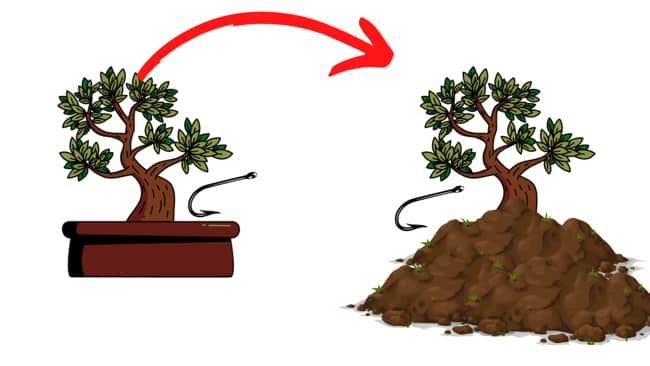
Remove the soil using a root hook
Repotting a bonsai also involves removing the old soil that was surrounding your bonsai.
The best thing for this I found is to use a root hook.
Once your bonsai has been removed from its pot then, gently go around the soil and roots unclumping and making the roots of your bonsai loose with the root hook
A nice trick would be to hold the root hook so that the hook is facing upwards and unclump the root ball that way.
A common question people have will be how much of the soil should they get rid of – I found that around 70 to 80% works best.
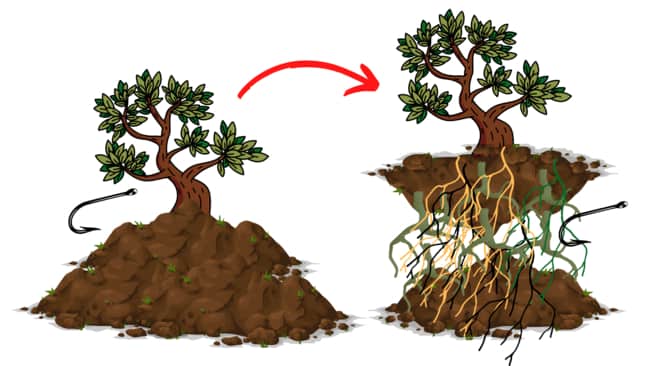
Cut any excess roots
During the process of removing the soil with the root hook, you will find that a lot of the roots will likely be holding onto the soil that has already been removed.
This will end up looking like the image below.
The best thing to do in this situation then is to simply use the root cutter and trim these excess roots.
You can then continue to remove the soil using the root hook until you have gotten to around that 70% mark.
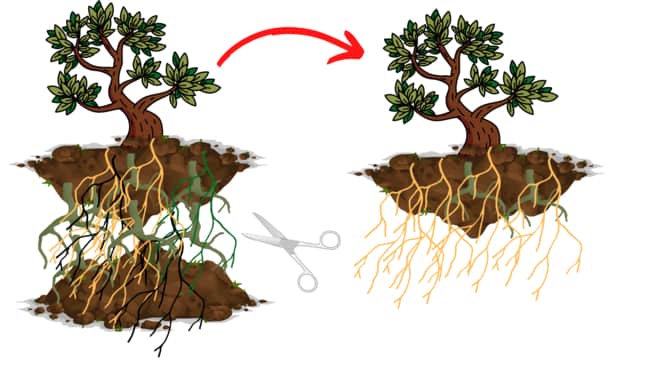
Trim the feeder roots
Once you have removed the excess soil or gotten to around the 70% of the size of your bonsai soil was the next thing you want to do is use the sheers to trim some of the feeder roots.
Feeder roots are often smaller than the larger-sized roots and directly feed your bonsai.
You do not want to trim these down directly, instead opting to cut these to promote new root growth which will be essential for your bonsai health when it moves into it’s new pot.
The new roots then will spread out from the point where these feeder roots have been cut.
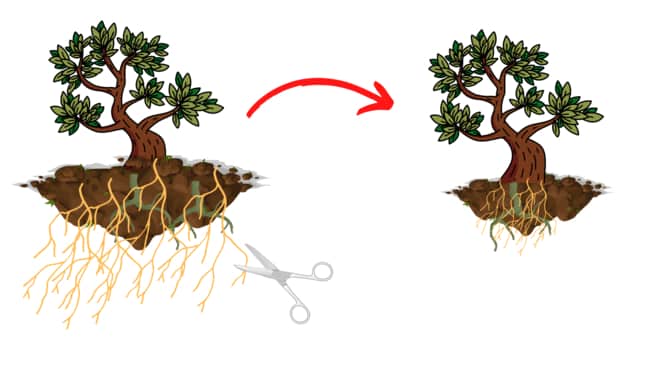
Prepare the drainage holes
So your bonsai has now been primed for repotting we now need to work on the pot.
Most bonsai pots have two drainage holes.
You want to cut the drainage mesh you have and place the square pieces over the two drainage holes.
This will keep the solid from falling out from your tree but also help prevent bugs from coming in.
To help keep the drainage mesh in place, use the 2mm wire.
Using the wire cutters cut two 6 inch strands of wire.
You then want to loop the strands of wire twice so each strand of wire will have two loops.
Then push the ends of the loop through the mesh and fold back on the other side.
This will secure the drainage mesh in place.
Easternleaf has a great video on their youtube channel explaining how to do this.
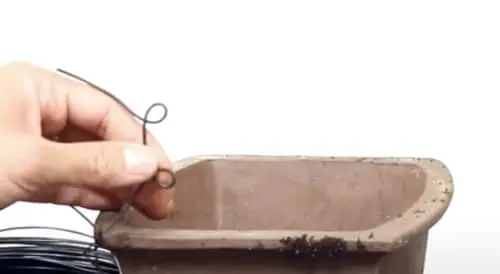
Add wire to secure the tree
So in the above step, we added wire to secure the drainage mesh so they do not move.
We then need to do the same for the tree.
To do this then, cut two 15 inch sections of copper wire.
Then thread each of these through the bottom drainage holes at a diagonal angle.
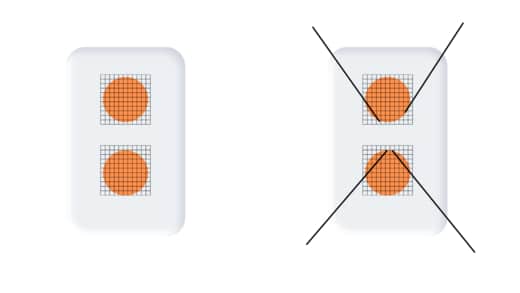
Apply a base layer of soil to your pot
So now our pot has been prepared we can start replanting.
Pour your solid of choice into the bottom of the bonsai pot – I like to use lava rock but have also found cactus soil to work well.
Pour this soil into the base of your pot. This will provide the tree with very good drainage.
You will also want to put a little hill of your soil mix right in the center of your pot.
This will aid the solid getting right in the middle of the roots.
Place the tree in the pot with the front-facing angle
The front of your bonsai tree is simply the angle that you display your bonsai tree where it looks the best.
Ideally, you should have more space in the front of the tree when behind so there should naturally be more solid in front of the trunk than behind it.
if you are new to bonsai, this should give you an idea of what to look out for.
The push the bonsai in the pot and ensure the bottom roots are touching the small soil hill you created in the step before.
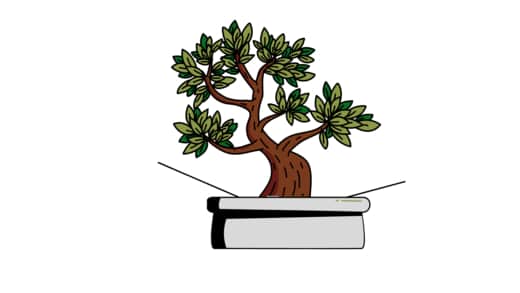
Fasten your bonsai
Using the copper wire stranded we used earlier, fasten the tree in place.
To do this wrap the copper wire around the trunk of the tree – ideally, so they are facing backward – you may need to use pliers to twist and secure them if your copper wire is loose.
Then trim the excess wire using the wire cutters.
You should have four strands at the start of this process and none left once completed.
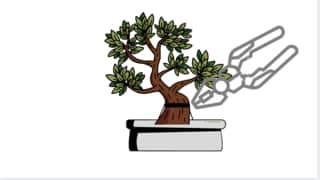
Add the topsoil
Now that your bonsai has been moved, the next step is to add the topsoil to your plant.
Simply put an even layer of your soil mix of choice until the top of the old soil mix has been covered.
Check for air holes
If your soil mix has too many air holes or air pockets this could potentially damage the roots as excess air will cause the roots to dry out.
To check then, use a repotting stick or a long thin stick such as a chopstick and poke the soil.
Air holes will naturally cause the topsoil to fall in so poke around the soil of your topsoil until all the air holes have been filled.
You might then need to top up the soil with more soil as if you have a lot of air pockets, the topsoil will fall into place.
Word to the wise, ensure you go around the perimeter of your pot too which can be notorious for air pockets.
Water your bonsai
Finally, ensure that you finish off by watering your bonsai.
Water the topsoil until wet and the water drains.
This will help remove any dust or excess that might have been clumped in your soil mix.
I personally like to water for about 30 seconds and then stop for t30 and then repeat around two or three times.
Bonsai repotting schedule by month
So for a lot of you, figuring out the ideal time to repot your bonsai in the spring will be a decision you have to make depending on your bonsai.
I appreciate however how difficult that can be sot o help make things a little easier, I’ve come up with a month by month play of when the best time to repot a bonsai will be:
| Month | Should you repot bonsai |
| January | No |
| February | No |
| March | Yes – Start looking for signs of buds that are swelling or expanding, if so repot your bonsai |
| April | Yes – Most bonsai will have completed energy transfer and started to bloom, the perfect months to repot bonsai |
| May | Yes – Most bonsai owners late to repotting their bonsai will do it in this month – |
| June | Yes – although not ideal, bonsai can still survive repotting in June. Just ensure you keep an eye out for the temperature |
| July | Yes – The last real month you can make any real progress repotting your bonsai. If repotted at the start of the month your plant should have enough time to recover from the stresses of repotting |
| August | Maybe – only the strongest and healthier of bonsai should be remitted this late into the summer. Only repot if necessary if your bonsai is suffering from root rot or diseases from overwatering your bonsai. |
| September | No – During September most bonsai will be getting ready for the fall. Colder temperatures mean that they will start the energy flow downwards towards the roots to prepare your bonsai for the winter months. |
| October | No |
| November | No |
| December | No |
When is the best time of year for repotting a bonsai?
The best time of year for repotting a bonsai is early spring when the bonsai buds start to swell or extend in the upper branches of the tree. This is a signal that the energy cycle has shifted and your bonsai will be able to recover much easier from the stressful repotting process.
Repotting bonsai in the summer is also an uncommon but viable option. Bonsai repotting in the fall or winter however should be avoided.
What is energy transfer when repotting bonsai?
One of the key indicators bonsai owners lookout for when repotting bonsai is bulging buds.
This is a surefire sign that energy transfer has occurred or the energy cycle is happening.
This is basically the process of bonsai moving the energy that it has stored up in the winter months in its roots and then moving them throughout the tree in spring.
When this happens, bonsai buds will start to bulge and eventually extend.
This then is the best time to repot your bonsai.
How to know when to repot your bonsai?
The optimal time to repot your bonsai is often preceded by buds appearing on your bonsai that start to swell or extend in the upper branches of your tree. This typically signifies the energy that has been kept in your bonsai roots now flowing through the rest of your tree.
This will allow your bonsai to recover more easily from the repotting process.
These signs then are most common in the first few weeks of the spring.
Energy transference is the best time of the year to repot a bonsai – typically happens right in the spring when flowers start to bloom
What are the alternatives to repotting a bonsai in the summer?
Root pruning can be a short-term alternative to repotting a bonsai. Instead of moving your bonsai out of its pot, bonsai owners would try to directly trim and prune any overgrown roots. This process however can prove difficult especially in bonsai trees with weak or numerous root systems.
Repotting a bonsai in the fall
Repotting a bonsai in the fall should be avoided at all costs. This is because during the autumn months bonsai are getting ready to go into the winter and will be storing energy. Should you repot a bonsai in the autumn then your bonsai will find it difficult to recover from the stressful process.
Will repotting a bonsai kill it?
Repotting a bonsai will not kill a bonsai. Repotting bonsai has been done for hundreds of years as a way to maintain and cultivate bonsai. To reduce the stress on a bonsai tree that comes with repotting bonsai, you should only repot in the spring or summer months.
What do the experts say about repotting a bonsai in the summer?
So like always, I didn’t just want to give my experience when it comes to repotting bonsai in summer and so I visited my local botanical gardens to get their advice. I spoke with one of the employees and this is what they said:
“ If you need to repot your bonsai you want to do it in the first few weeks of spring”
I also undertook a poll of 20 plant paladin members asking them when they repot their bonsai and what month of the year they repot their bonsai and here are the results :
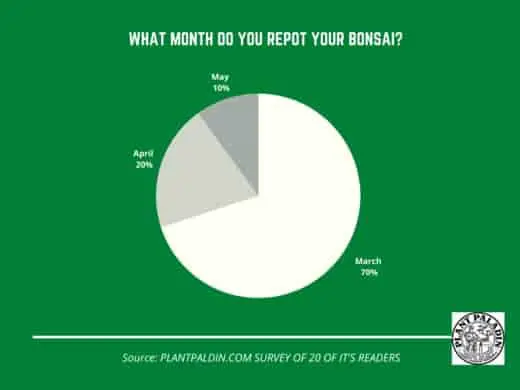
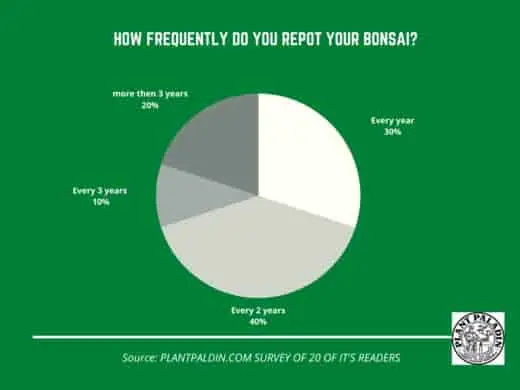
My top picks for the gear you will need!
So like I mentioned earlier, over the past three years of running PlantPaladin, hundreds of people have asked me for my recommendations on the best bonsai gear on the market.
Having spent thousands of dollars on bonsai items these past few years and tested at least 100 bonsai-specific products, I’ve listed my favorite products below – All of which I highly recommend and think you can get great value.
They can purchase directly by clicking the link to take them to Amazon.
Bonsai Tool Set: One of the significant challenges I’ve had is finding a toolset that was not only durable but didn’t break the bank. SOLIGT has recently developed a fantastic bonsai tool set that covers all the tools you need to trim, prune, and repot your trees. – You can grab it here.
Complete Bonsai Set: Many of you will want to grow your bonsai trees entirely from scratch, but finding the varicose seeds, pots, and other items in one place can be challenging. Leaves and Sole then have created a complete bonsai set that I’ve personally used that ticks all the boxes. You can grab it here.
Bonsai wire: The number of times I’ve run out of wire for my bonsai or purchased cheap bonsai wire that doesn’t do the job is embarrassing for me to admit. After a lot of trial and error, I found that using Hotop’s aluminum bonsai wire is one of the best options on the market. This can easily be used for both indoor and outdoor bonsai. You can grab it here.
This post was written by Fehed Nicass who has been passionate about bonsai for over 2 years.

